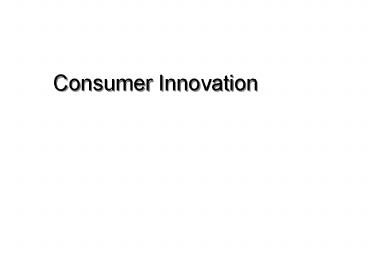Arnould - PowerPoint PPT Presentation
1 / 21
Title:
Arnould
Description:
... could be taken to initiate a bandwagon effect for online publishing and payment? ... Bandwagons can be created by soliciting referrals and testimonials ... – PowerPoint PPT presentation
Number of Views:39
Avg rating:3.0/5.0
Title: Arnould
1
Chapter
17
Consumer Innovation
2
Objectives
- Distinguish characteristics of innovations that
influence their rate of diffusion and help
determine their market success. - Distinguish diffusion and adoption processes.
- Describe reasons for resistance to change and for
discontinuance. - Describe strategies for changing attitudes and
behavior. - Identify and distinguish opinion leaders, market
mavens, and innovative consumers important in the
diffusion of innovations. - Describe differences among consumers based on
their time of adoption of innovations.
3
Innovation
- Capitalism encourages the creation of new
markets, new technologies, and new forms of
industrial organization. - Innovation and Change
- Innovation and change are the heart of marketing.
- While some marketers ask consumers to be
innovative, in terms of what they buy, how they
buy, and where to buy, others encourage consumers
to be conservative and resistant to change. - Innovation refers to new things and ideas and new
ways of behaving and interacting with things
(symbolic and technological). - It is defined by individuals and social groups.
- It include ideas, business practices, behaviors.
- It is one component of the diffusion process.
4
Types of Innovations
- Continuous innovations
- Examples?
- Dynamically continuous innovations
- Examples?
- Discontinuous innovations
- Examples?
5
Innovation Characteristics that Influence New
Product Adoption
- Pioneering advantage
- Being the first firm to market a product
successfully in an emerging market. - Prerequisites for Successful Adoption/AKA
Barriers to Adoption - Relative advantage
- Compatibility
- Trialability
- Observability
- Complexity
6
New Product Success or Failure Why?
- Nair for MEN Hair Remover Currently in test
market, this body cream removes hair from back,
chest, arms and legs. Research by NPW three years
ago indicated a market for smooth skin among
active, young men. The big question is how big
the opportunity is for Carter-Wallaces Nair -the
leader in hair removal for women.
http//www.newproductworks.com/product_poll/produc
t_poll.html, accessed 2/14/05
7
New Product Success or Failure Why?
- e-Moo Manufactured by MAC Farms, Inc., this
carbonated dairy-based beverage contains all the
nutrition of skim milk. In 8fl. oz plastic
bottles and retailing for .69, it comes in
Orange Sparkle, Bubble Gum and Chocolate
Raspberry flavors. This patent pending process
for carbonating milk is geared to kids and
families as a more healthful fun beverage.
http//www.newproductworks.com/product_poll/produc
t_poll.html, accessed 2/14/05
8
New Product Success or Failure Why?
- Campbells Soup to Sip Currently in test
market, Campbells latest is a plastic 10 3/4 oz
travel mug. The zip open metal lid is removed
to heat in the microwave and is then replaced
with a plastic travel lid. Targeted for on-the-go
meals, (i.e., portafuels), this product offers
the taste of Campbells classic soups, (Creamy
Chicken, Classic Tomato, Blended Vegetable Medley
and Cream of Broccoli varieties) in the
convenience of your own disposable travel mug.
Priced at 1.49 per unit.
http//www.newproductworks.com/product_poll/produc
t_poll.html, accessed 2/14/05
9
The Study of Consumer Change
- The Diffusion Process
- the spread of an innovation from its creative
source across space and time - Product Life Cycle (PLC)
- a generic PLC takes the shape of an S-curve,
because it mimics the adoption pattern. - Key Components
- Space
- Time
- Neighborhood effect
- Fads, Fashions, and Trends
10
Exhibit 17.2Diffusion Curves
Arnould et al. slide
11
Conservatism, Resistance, and Discontinuance
- Pro-innovation bias
- Innovation resistance
- Discontinuance
- Why?
- E.g., Snob effect
12
Exhibit 17.4 Group Influence on Innovative
Behaviors
Arnould et al. slide
13
Social Hierarchies
- Social system values and traditions influence
innovation. - Trickle down theory of innovation
- Two-step flow model
14
Exhibit 17.5 Multistep Media Flow Model of
Communication
Arnould et al. slide
15
Adoption
- The adoption process focuses on the stages
individual consumers or organizational buying
units pass through in making a decision to accept
or reject an innovation. - Adopter Categories
- Lead Users
- Innovators
- Early Adopters
- Early Majority
- Late Majority
- Laggards
16
Exhibit 17.6 Diffusion and the PLC
Arnould et al. slide
17
The Adoption Process
- Awareness
- Interest
- Trial
- consumer surrogates
- Adoption (or rejection)
- Frequently, marketing objectives are stated in
terms of where particular market segments are
desired to be along the adoption process
18
(No Transcript)
19
Online Publishing Case
- Identify the innovations described in the case.
- Classify each innovation in terms of the three
categories of innovation described in the text.
Justify your answer. - Identify barriers to adoption for each
innovation, from the five identified in the
chapter. - What marketing steps could be taken to initiate a
bandwagon effect for online publishing and
payment?
20
Key Points from the Case
- Discontinuous innovation witnessed in payment
plan and the way the book was to be purchased and
read - Major barriers were relative advantage (most
importantly), complexity, observability, and
compatibility trialability was probably the
only thing it had going for it
21
Key Points from the Case
- Bandwagons can be created by soliciting referrals
and testimonials - BUT, in the end, have to understand how the
consumer is going to think about and experience
the product - Just because it can be done, doesnt mean it
should be done































